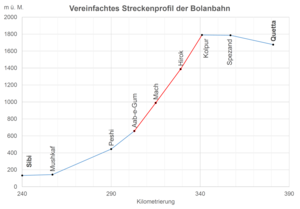Sibi – Quetta railway line
| Sibi-Quetta | |||||||||||||||||||||||||||||||||||||||||||||||||||||||||||||||||||||||||||||||||
|---|---|---|---|---|---|---|---|---|---|---|---|---|---|---|---|---|---|---|---|---|---|---|---|---|---|---|---|---|---|---|---|---|---|---|---|---|---|---|---|---|---|---|---|---|---|---|---|---|---|---|---|---|---|---|---|---|---|---|---|---|---|---|---|---|---|---|---|---|---|---|---|---|---|---|---|---|---|---|---|---|---|
|
Train of the Bolan Railway on the plateau near Kolpur
| |||||||||||||||||||||||||||||||||||||||||||||||||||||||||||||||||||||||||||||||||
|
Simplified route profile of the Bolanbahn
red: steep route with a 40 ‰ gradient | |||||||||||||||||||||||||||||||||||||||||||||||||||||||||||||||||||||||||||||||||
| Route length: | 141 km | ||||||||||||||||||||||||||||||||||||||||||||||||||||||||||||||||||||||||||||||||
| Gauge : | 1676 mm ( colonial track ) | ||||||||||||||||||||||||||||||||||||||||||||||||||||||||||||||||||||||||||||||||
| Maximum slope : | 40 ‰ | ||||||||||||||||||||||||||||||||||||||||||||||||||||||||||||||||||||||||||||||||
|
|||||||||||||||||||||||||||||||||||||||||||||||||||||||||||||||||||||||||||||||||
The Sibi – Quetta railway , also known as the Bolan Railway , is a 141-kilometer-long railway line operated by Pakistan Railways with a gauge of 1676 mm in Balochistan and connects Sibi with Quetta via the Bolan Pass . Part of the railway line was originally equipped with the three-lamellar rack system Abt .
history


The double-lane line over Bolanpass, built between 1880 and 1891 under Field Marshal Lords Roberts , is one of the greatest engineering achievements of British rule in India . In 1876, the British government commissioned the planning of a railway over the Bolan Pass , primarily for reasons of military strategy . Construction began in 1880, but was stopped after the 31 km route had been laid because of the Battle of Maiwand . In 1885 work was resumed by laying a track along the Bolan River. In August 1886 the railroad reached the end of the line in Quetta.
The railway line over the Bolan Pass, with its hot temperatures in summer and extreme cold in winter, had to be re-routed several times. In 1889, a torrential flood destroyed the stretch of the Bolan River. A higher route was in turn washed away by a flood. The route used today was commissioned in 1890 and inaugurated on April 15, 1897. In some places along the route you can still see the abandoned tunnels and the track bed of the two original routes.
The Bolan Railway from Sibi to Quetta has 17 tunnels and crosses the Bolan River several times. On a 20.0-long section between Aab-e-Gum and Kolpur with gradients of 40 ‰, there were originally 11.2 km of three-lamellar rack and pinion system Abt with a gradient of 40 ‰ and tight curves with a 180 m radius. During steam operation, up to four locomotives were used for a train between Aab-e-Gum and Kolpur.
business
Most trains are supported by a pushing locomotive on the ascent from Aab-e-Gum to Kolpur, Pakistan's highest railway station . A single 2400 hp diesel locomotive that pulls 70 freight cars to Sibi only transports 14 cars from Sibi to Aab-e-Gum. An additional push-pull locomotive is required for the journey from Aab-e-Gum to Kolpur. For the descent, the diesel locomotives are equipped with a resistance brake in order to keep the trains in a wear-free manner. Some freight trains are given 5 to 10 empty wagons that serve as brake cars.
The Bolan Railway is part of the Pakistani main line network and is served by several express trains:
- Akbar Express: Lahore - Bahawalpur - Jacobabad - Sibi - Quetta
- Baluchistan Express: Karachi - Sukkur - Sibi - Quetta
- Bolan Mail: Karachi – Jacobabad – Sibi – Quetta
- Jaffar Express : Peshawar –Bahawalpur – Jacobabad – Sibi – Quetta
See also
literature
- Owais Mughal: Railway line through the Bolan Pass. In: IRFCA, the Indian Railways Fan Club. August 23, 2008, accessed August 15, 2017
- Map on Google Maps , accessed on August 15, 2017
Web links
- Inamul Haque Quetta to Lahore in 1925, edited by Izaz Haque. In: IRFCA, the Indian Railways Fan Club. 2010 (English), accessed August 15, 2017
Individual evidence
- ↑ Twenty-five year anniversary of the System Dept. In: Schweizerische Bauzeitung . Volume 50 (1907), issue 10 (E-Periodica.ch, PDF; 0.4 MB).
- ↑ cog railway at the Bolan Pass, India. In: Schweizerische Bauzeitung . Volume 17 (1891), issue 18 (E-Periodica.ch, PDF; 1.5 MB).
- ^ Train Timings at Quetta Railway Station. In Pakistan Railway Time Table , accessed August 15, 2017


